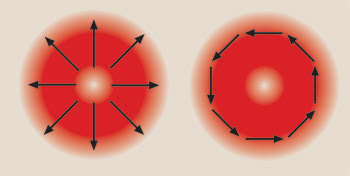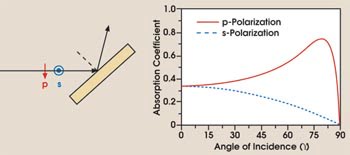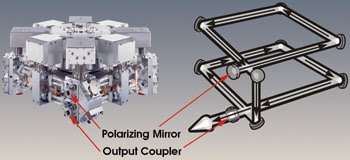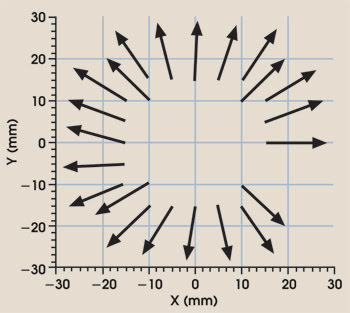
CO2 Laser Generates 3 kW in Cylindrically Polarized Beam
Cylindrical polarization is better than linear or circular for cutting and drilling.
Breck Hitz
A collaboration of European scientists has recently generated what they believe is the highest power ever achieved in a radially polarized laser beam, by fitting a commercial Trumpf CO2 laser with a specialized end mirror. That is significant because previous studies by other investigators have shown that cylindrically polarized light is more efficient than other polarizations for many cutting and drilling applications.
Just as there are two varieties of plane-polarized light (vertical and horizontal), there are two varieties of cylindrically polarized light, radial and azimuthal. In a radially polarized laser beam, the E-vector is always directed outward from the center; in an azimuthally polarized beam, the E-vector is always tangential to the beam circumference (Figure 1).

Figure 1. Shown is the orientation of the electric-field vector in a radially (left) and azimuthally (right) polarized laser beam. For some materials processing applications, the donut intensity profile, shown here, is better than the Gaussian profile.
Cylindrically polarized light has been exploited in high-power solid-state amplifiers because it takes advantage of the cylindrical thermal isotherms in laser rods. The isotherms create a cylindrically symmetric birefringence in the rods that depolarizes planar polarized light but that has no effect on cylindrically polarized light. Thus, cylindrically polarized light can be amplified more efficiently than plane-polarized light (See “Cylindrical Polarization: the Path to High Power” on page 93 of August Photonics Spectra).
But theoretical [A.V. Nesterov and V.G. Niziev (2000). J PHYS D: APPL PHYS, pp. 1817-1822] and experimental [M. Meier et al (2007). APPL PHYS A, pp. 329-334] studies also have shown that cylindrically polarized light can be superior to planar or circularly polarized light in many materials processing applications, for several reasons. Probably the most straightforward has to do with the amount of light that is absorbed at the material interface as a function of the angle of incidence (Figure 2). When a laser cuts or drills a workpiece, the laser beam is usually normal to the workpiece, but that does not mean the beam is normal to the air-material (or vacuum-material) interface. The laser beam is creating a hole or trough in the workpiece, and the angle of incidence is the angle between the laser beam and the edge of the hole or trough.

Figure 2. Which is s, and which is p? The p-polarization lies in the plane containing the incident and reflected beams, and the s-polarization is orthogonal to the plane (left). For an oblique angle of incidence, the absorption coefficient for the p-polarization is always higher than that for the s-polarization (right).
Studies have shown that, for cutting, radially polarized light can be twice as effective as the circularly polarized light that is commonly used today for cutting because radially polarized light is always the p-polarization with respect to the edge of the trough being cut in the workpiece, and the p-polarization is absorbed best (Figure 1). For drilling, the situation is somewhat different, and other studies show that azimuthally polarized light is sometimes the best solution. Nonetheless, the goal of the current work was to create a powerful, radially polarized CO2 laser beam.

Figure 3. The scientists modified a Trumpf TruFlow CO2 laser by replacing the normally high-reflectance mirror with a mirror that preferentially reflected the radial polarization. Reprinted with permission of Optics Letters.
The investigators, affiliated with Universität Stuttgart, with Trumpf Laser- und Systemtechnik GmbH in Ditzingen, both in Germany, and with Saint-Etienne University in France, started with a Trumpf TruFlow CO2 laser normally capable of 3200 W in a linearly polarized beam (Figure 3). They replaced the high-reflectance mirror with a mirror that reflected only ∼41 percent of the azimuthally polarized light but more than 99 percent of the radially polarized light. This high loss to the azimuthal polarization prevented it from reaching threshold in the laser, and only the radial polarization oscillated.

Figure 4. The arrows indicate the measured polarization direction at different positions across the laser beam’s cross section. Reprinted with permission of Optics Letters.
The mirror that provided this discrimination against the azimuthal polarization was of a unique design. The scientists overlaid a circular diffraction grating on a multilayer dielectric mirror. In the absence of the grating, the mirror reflected more than 99 percent of any incident polarization, but the grating coupled more than half of the incident azimuthal polarization to leaky modes of the mirror’s multimode waveguide.
To confirm the polarization state of the laser with the special mirror, the scientists scanned the enlarged beam with a rotating polarizer. The result indicated a nearly perfect radially polarized beam (Figure 4). In long-term testing, they operated the laser at 2.7 kW for several hours and observed that both the power and polarization were steady over that period.
Optics Letters, July 1, 2007, pp. 1824-1826.
Published: September 2007